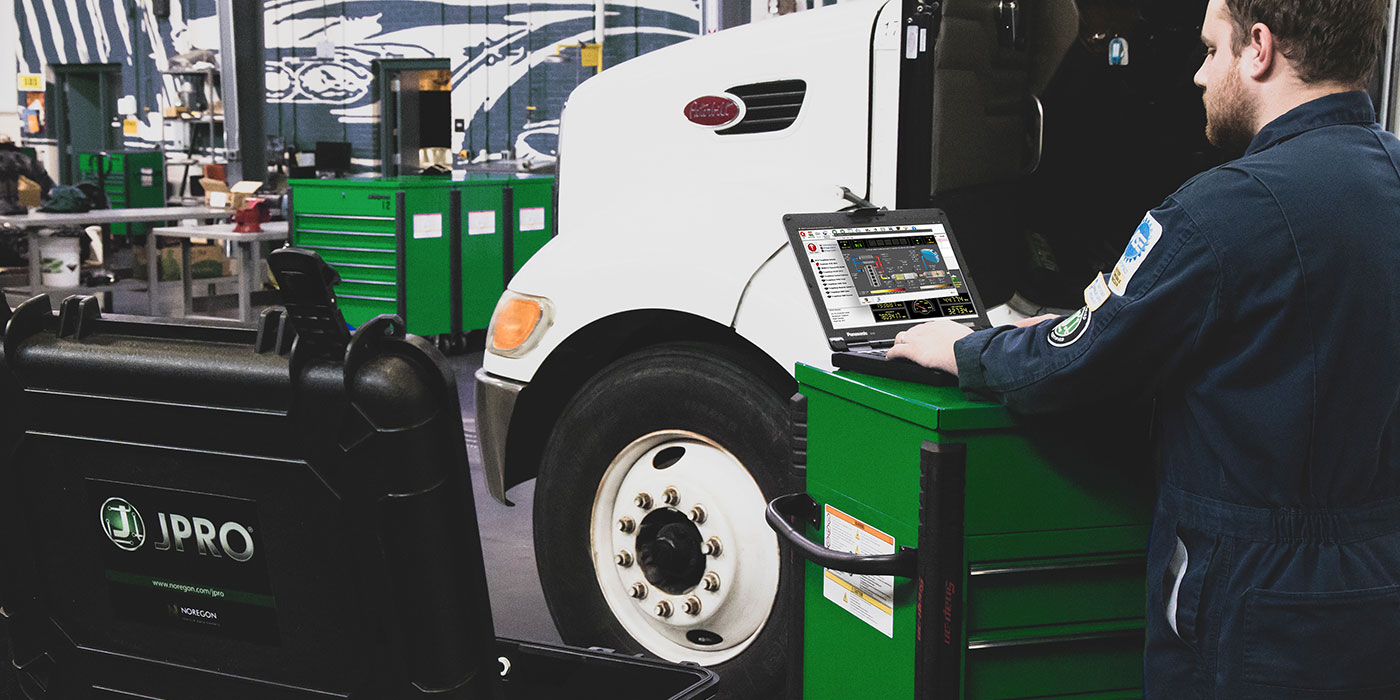Primarily a means of facilitating service operations and enabling technicians to more safely and productively work on vehicles, properly specified, installed and maintained shop lifts can provide measurable improvements in safety and productivity.
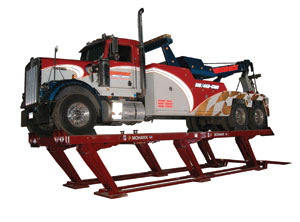
Vehicle lifts provide convenient access to serviceable parts, enabling technicians to get more work done in less time. Designed to safely raise vehicles to a comfortable working height, they can result in less strain on technicians and fewer injuries.
Before choosing a lift, fleet managers assess needs that include the types of services a facility performs. Vehicle lift selection and placement should also be part of an overall shop planning process. Each lift model and type, for example, has its own footprint. Also to be considered are the turning radius and length of vehicles being serviced in the facility to ensure that they can be driven into position onto or over each lift without a lot of maneuvering.
Foot traffic also is an important consideration. Lift columns, cords and other obstructions can cause significant amounts of lost time, so designs that offer a clear floor may improve efficiency.
Once lifts are installed, it is essential that technicians operating them know how use them correctly. All reputable lift manufacturers offer training materials for this purpose.
To keep lifts functioning properly, manufacturers also advise that fleets follow maintenance, adjustment and lubrication recommendations. For example, proper lubrication using oil designed for this purpose is crucial to maintaining lift performance and longevity. This is especially important for lifts that are driven by a cable or chain.
While technicians can perform most routine lift maintenance, qualified lift service personnel should handle annual inspections, repairs and certain tasks, such as seal replacement or pressure testing. Manufacturers also recommend using only original equipment replacement parts to ensure proper fit and function.
Lift types
There are several types of lifts used in truck maintenance facilities, including:
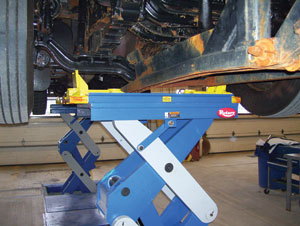
In-Ground Lifts provide the best access to a vehicle, occupy less shop space than surface lifts and make it easy to move vehicles in and out of service areas. These lifts, which raise a vehicle by its axles, retract into the ground when not in use.
Two-Post Lifts feature two sets of lifting arms attached to two columns. The vehicle is driven between the columns, and the arms are manually positioned under the vehicle to lift it at designated pick-up points on the frame. Two-post lifts typically come in asymmetrical and symmetrical designs. Symmetrical designs are preferred for use on large vehicles because the load must be centered between the columns longitudinally. These lifts provide easy access to most of the vehicle undercarriage and drivetrain.
Four-Post Lifts are drive-on designs featuring runways, which are raised once the vehicle is in position. These lifts are the fastest to use because no set-up is required to raise the vehicle to a comfortable working height. While the vehicle is supported on its wheels, four-post lifts can be fitted with rolling jacks to lift the front or rear wheels off the runways. These lifts also can be equipped with alignment kits. Four-post lifts are available in a variety of lengths and lifting capacities with adjustable runway track widths to accommodate most vehicles.
Parallelogram Lifts feature runways that are raised using a parallelogram motion. Like four-post lifts, the vehicle is driven onto runways, which are then raised. Also one of the fastest lift styles to use because no set-up is required, these lifts also support the vehicle on its wheels, and can be fitted with rolling jacks to lift the front or rear off the runways. There are three general types of parallelogram lifts, including surface mount, surface with recessed mount and flush mount types. Surface-mount lifts are anchored to the shop floor like a four-post lift. The platforms of flush mount parallelogram lifts recess into individual cavities in the floor when the lift is lowered.
Mobile Column Lifts consist of four or six portable columns linked by a common control circuit. The columns are wheeled to the vehicle and connected together via control cables for synchronized lifting. Portable and flexible, these lifts can turn empty space into a repair or inspection area.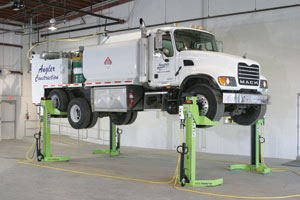
Pit Lifts are added to existing service pits to expand the maintenance and repair tasks that can be performed. Three types include floor-running, rail-mounted and suspended. Floor-running pit lifts have wheels so technicians can roll them anywhere in the pit. Rail-mounted lifts move along a rail system at the bottom of the pit. Suspended pit lifts ride on rails installed at the top of the pit.
Lift certification
Regardless of the type of lift chosen for a particular shop, an important consideration is whether the product is certified, and a sure sign of quality is certification by the Automotive Lift Institute (ALI). The industry association founded by vehicle lift manufacturers promotes the safe design, construction, installation, operation and maintenance of lifts, including those used to service commercial vehicles.
ALI testing includes verification of the structural integrity of a lift’s systems and components, proper function of its controls and load-holding devices, proper lowering speeds, and overload protection. ALI also has developed standards covering a lift owner’s responsibilities regarding operation, inspection and maintenance, as well as a standard on the installation and service of vehicle lifts. Visit the ALI website at www.autolift.org for more information.
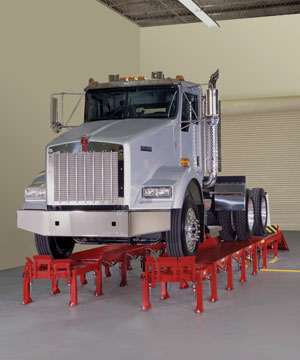
Rotary Lift’s line of vehicle lifts includes the newly introduced EFX60, a heavy-duty, in-ground scissor lift that features a universal style lifting saddle with flip-up adapters and an infinite adapter adjustment range. The adapters also swivel, making it possible to pick up vehicles by either the frame or the axle. The EFX60 can lift virtually any medium-duty or heavy-duty vehicle weighing up to 60,000 lbs.
Rotary also provides the MACH 4 Plus Mobile Column Hydraulic (MCH) lift that consists of four columns with adjustable wheel forks for different wheel sizes. In addition, it is a manufacturer of in-ground and parallelogram lift systems, as well as a range of suspended and floor-running pit lifts.
Ari-Hetra offers a full line of heavy-duty lifting systems built to handle 48,000- to 320,000-lb. loads. Drive-on models from the manufacturer include Surface Mounted Scissor Lifts and Flush Mounted Scissor Lifts with sealed bronze and graphite pivot points, structural ribs under platforms, and platforms wide enough for dual-wheel vehicles.
Ari-Hetra also provides a Mobile Lifting Platform powered by dual industrial strength batteries and a hybrid power system. The power-saving lift, which conserves energy by powering down after two minutes of inactivity, uses the weight from a lifted vehicle to regenerate power, which is stored in the batteries.
Mohawk Lifts offers two-post lifts in 26,000- and 30,000-lb. capacity models. These lifts are hydraulically equalized, using a pair of height adjustable overhead hydraulic lines (optional underground lines available).
Mohawk four-post lifts range from 19,000- to 75,000-lb. capacities. In-ground lifts from the manufacturer come in 55,000-, 66,000-, 82,500- and 99,000-lb. capacities. Mohawk mobile column style lifts have per column capacity ratings of 12,000 to 40,000 lbs. The company also offers a range of parallelogram lifts with capacities from 36,000 to 100,000 lbs.
Hunter Engineering’s RKHD Heavy-duty Power Rack lift is easy to use and offers the benefits of a pit rack without the cost, the maker said. The heavy-duty lift has adjustable front wheel stops to provide clearance during vehicle operations. It also has 33-in. wide runways to make drive-on/drive-off easier and safer, and it includes a super-strong truss design that provides 20,000 lbs. per axle capacity.
The company noted pop-up ramps add wheelbase capacity while making efficient use of bay space. Automatic wheel stops engage when ramps are raised to up position. Ramp legs safely lock in over-center position at maximum rise.
An optional jack tray with wheels and guides simplifies alignment and other service operations that require jacking.
An option for bottle jacks is also available, the company added.












